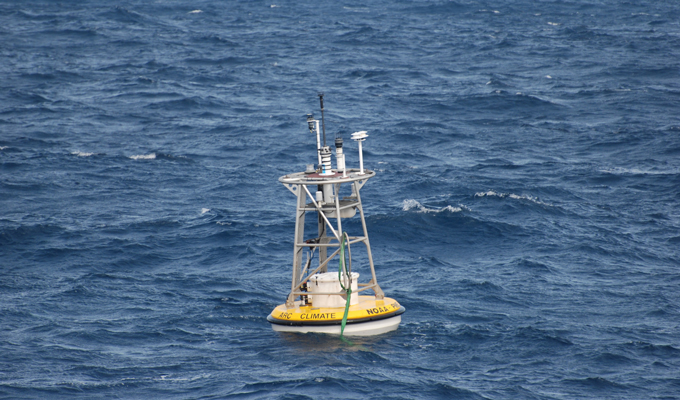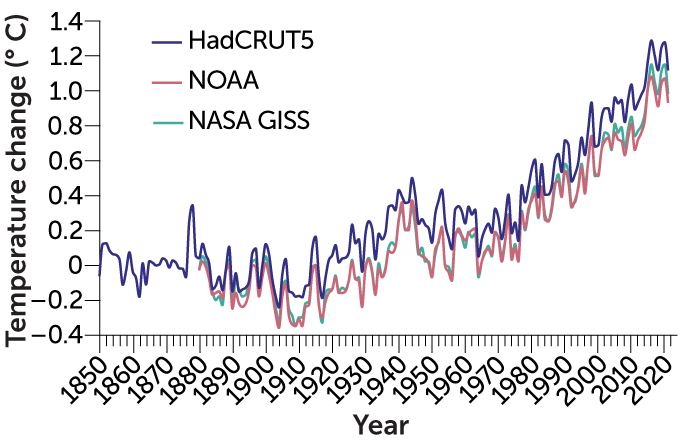It was one of the biggest climate change questions of the early 2000s: Had the planet’s rising fever stalled, even as humans pumped more heat-trapping gases into Earth’s atmosphere?
By the turn of the century, the scientific understanding of climate change was on firm footing. Decades of research showed that carbon dioxide was accumulating in Earth’s atmosphere, thanks to human activities like burning fossil fuels and cutting down carbon-storing forests, and that global temperatures were rising as a result. Yet weather records seemed to show that global warming slowed between around 1998 and 2012. How could that be?

To celebrate our 100th anniversary, we’re highlighting some of the biggest advances in science over the last century. To see more from the series, visit Century of Science.
ReAD MORE
After careful study, scientists found the apparent pause to be a hiccup in the data. Earth had, in fact, continued to warm. This hiccup, though, prompted an outsize response from climate skeptics and scientists. It serves as a case study for how public perception shapes what science gets done, for better or worse.
The mystery of what came to be called the “global warming hiatus” arose as scientists built up, year after year, data on the planet’s average surface temperature. Several organizations maintain their own temperature datasets; each relies on observations gathered at weather stations and from ships and buoys around the globe. The actual amount of warming varies from year to year, but overall the trend is going up, and record-hot years are becoming more common. The 1995 Intergovernmental Panel on Climate Change report, for instance, noted that recent years had been among the warmest recorded since 1860.
And then came the powerful El Niño of 1997–1998, a weather pattern that transferred large amounts of heat from the ocean into the atmosphere. The planet’s temperature soared as a result — but then, according to the weather records, it appeared to slacken dramatically. Between 1998 and 2012, the global average surface temperature rose at less than half the rate it did between 1951 and 2012. That didn’t make sense. Global warming should be accelerating over time as people ramp up the rate at which they add heat-trapping gases to the atmosphere.
 Today’s ocean-monitoring buoys (a NOAA buoy southeast of South Africa is shown) provide measurements of ocean surface temperatures that are more accurate than previous approaches.D. MacIntyre, NOAA
Today’s ocean-monitoring buoys (a NOAA buoy southeast of South Africa is shown) provide measurements of ocean surface temperatures that are more accurate than previous approaches.D. MacIntyre, NOAA
By the mid-2000s, climate skeptics had seized on the narrative that “global warming has stopped.” Most professional climate scientists were not studying the phenomenon, since most believed the apparent pause fell within the range of natural temperature variability. But public attention soon caught up to them, and researchers began investigating whether the pause was a real thing. It was a high-profile shift in scientific focus.
“In studying that anomalous period, we learned a lot of lessons about both the climate system and the scientific process,” says Zeke Hausfather, a climate scientist now with the technology company Stripe.
By the early 2010s, scientists were busily working to explain why the global temperature records seemed to be flatlining. Ideas included the contribution of cooling sulfur particles emitted by coal-burning power plants and heat being taken up by the Atlantic and Southern oceans. Such studies were the most focused attempt ever to understand the factors that drive year-to-year temperature variability. They revealed how much natural variability can be expected when factors such as a powerful El Niño are superimposed onto a long-term warming trend.
Scientists spent years investigating the purported warming pause — devoting more time and resources than they otherwise might have. So many papers were published on the apparent pause that scientists began joking that the journal Nature Climate Change should change its name to Nature Hiatus.

Sign Up For the Latest from Science News
Headlines and summaries of the latest Science News articles, delivered to your inbox
Client key* E-mail Address* Go
Thank you for signing up!
There was a problem signing you up.
Then in 2015, a team led by researchers at the U.S. National Oceanic and Atmospheric Administration published a jaw-dropping conclusion in the journal Science. The rise in global temperatures had not plateaued; rather, incomplete data had obscured ongoing global warming. When more Arctic temperature records were included and biases in ocean temperature data were corrected, the NOAA dataset showed the heat-up continuing. With the newly corrected data, the apparent pause in global warming vanished. A 2017 study led by Hausfather confirmed and extended these findings, as did other reports.
Even after these studies were published, the hiatus remained a favored topic among climate skeptics, who used it to argue that concern over global warming was overblown. Congressman Lamar Smith, a Republican from Texas who chaired the House of Representatives’ science committee in the mid-2010s, was particularly incensed by the 2015 NOAA study. He demanded to see the underlying data while also accusing NOAA of altering it. (The agency denied fudging the data.)
“In retrospect, it is clear that we focused too much on the apparent hiatus,” Hausfather says. Figuring out why global temperature records seemed to plateau between 1998 and 2012 is important — but so is keeping a big-picture view of the broader understanding of climate change. The hiccup represented a short fluctuation in a much longer and much more important trend.
Global average temperature change, 1850–2021
 E. OTWELL; SOURCE: NASA, NOAA, MET OFFICE HADLEY CENTRE. HADCRUT5 DATA WAS SET TO A BASELINE OF 1850–1900. NOAA AND NASA DATA WERE VERTICALLY ALIGNED WITH IT USING A REFERENCE PERIOD OF 1981–2010.E. OTWELL; SOURCE: NASA, NOAA, MET OFFICE HADLEY CENTRE. HADCRUT5 DATA WAS SET TO A BASELINE OF 1850–1900. NOAA AND NASA DATA WERE VERTICALLY ALIGNED WITH IT USING A REFERENCE PERIOD OF 1981–2010.
E. OTWELL; SOURCE: NASA, NOAA, MET OFFICE HADLEY CENTRE. HADCRUT5 DATA WAS SET TO A BASELINE OF 1850–1900. NOAA AND NASA DATA WERE VERTICALLY ALIGNED WITH IT USING A REFERENCE PERIOD OF 1981–2010.E. OTWELL; SOURCE: NASA, NOAA, MET OFFICE HADLEY CENTRE. HADCRUT5 DATA WAS SET TO A BASELINE OF 1850–1900. NOAA AND NASA DATA WERE VERTICALLY ALIGNED WITH IT USING A REFERENCE PERIOD OF 1981–2010.
Long-term climate datasets show that Earth’s average surface temperature (combined land and ocean) has increased by more than 1 degree Celsius since preindustrial times. Temperature change is the difference from the 1850–1900 average.
Science relies on testing hypotheses and questioning conclusions, but here’s a case where probing an anomaly was taken arguably too far. It caused researchers to doubt their conclusions and spend large amounts of time questioning their well-established methods, says Stephan Lewandowsky, a cognitive scientist at the University of Bristol who has studied climate scientists’ response to the hiatus. Scientists studying the hiatus could have been working instead on providing clear information to policy makers about the reality of global warming and the urgency of addressing it.
The debates over whether the hiatus was real or not fed public confusion and undermined efforts to convince people to take aggressive action to reduce climate change’s impacts. That’s an important lesson going forward, Lewandowsky says.
“My sense is that the scientific community has moved on,” he says. “By contrast, the political operatives behind organized denial have learned a different lesson, which is that the ‘global warming has stopped’ meme is very effective in generating public complacency, and so they will use it at every opportunity.”
Already, some climate deniers are talking about a new “pause” in global warming because not every one of the past five years has set a new record, he notes. Yet the big-picture trend remains clear: Global temperatures have continued to rise in recent years. The warmest seven years on record have all occurred since 2015, and each decade since the 1980s has been warmer than the one before.

